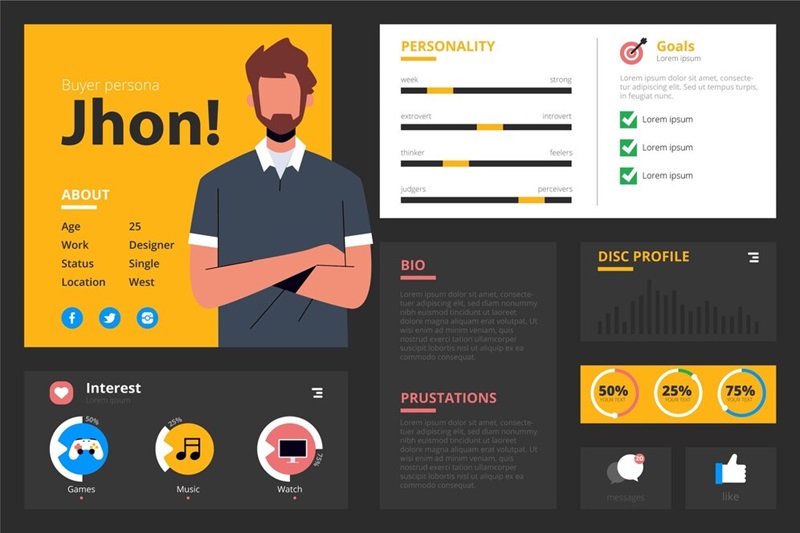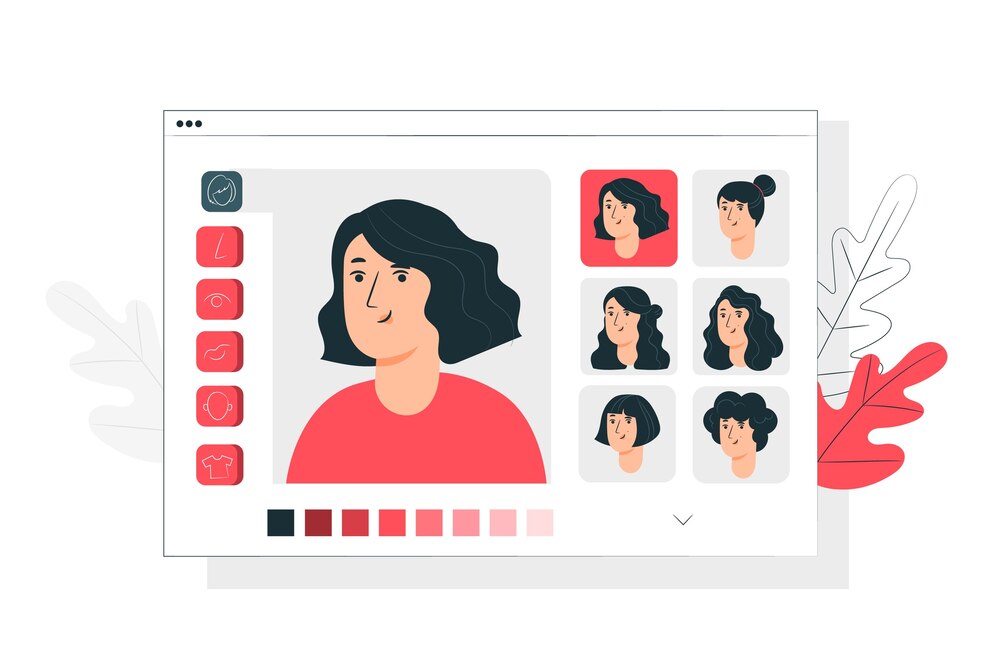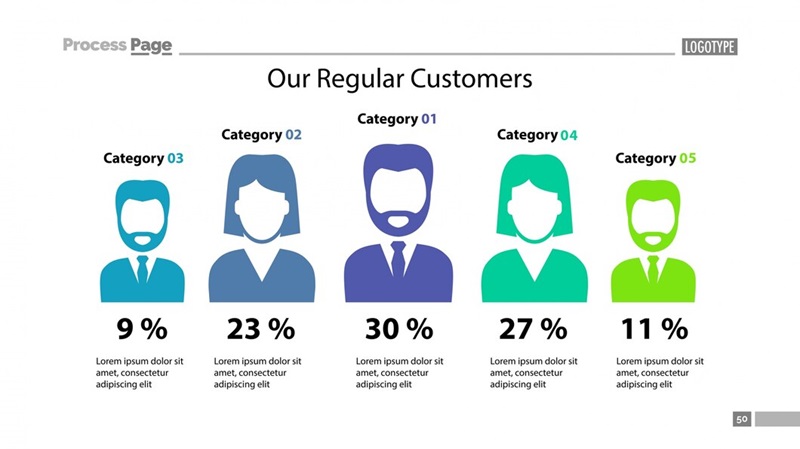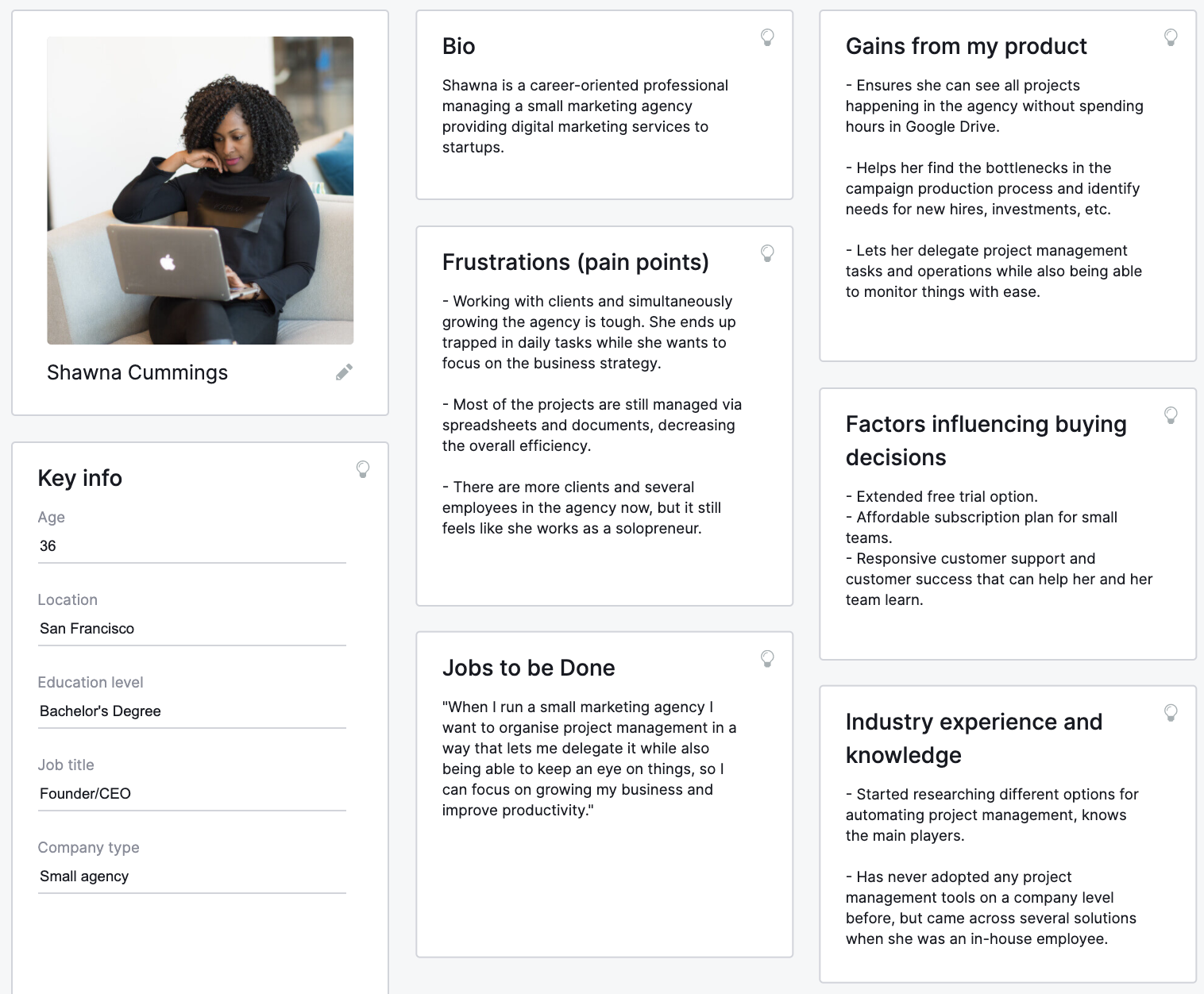Understanding customers, their needs, and problems, is the cornerstone of any successful business strategy. A customer persona serves as a valuable resource for gaining insight into your market. But what is a customer persona, exactly, and how can it benefit your business?
The success of any business hinges on its customers, whether it’s an established enterprise or a newer venture. Providing a positive purchasing experience is crucial for business growth and increasing brand awareness.
Companies that prioritize customer experience tend to generate more revenue compared to their competitors. To truly differentiate yourself from the countless other businesses offering similar solutions, it’s essential to empathize with your customers and see things from their perspective.
Creating detailed customer personas is a vital step in this process. These personas extend beyond basic demographic information and delve deep into the interests, needs, and pain points of your target audience. As you continue reading, you’ll discover how these personas can greatly enhance your marketing strategies, allowing you to tailor your messages and craft a seamless customer journey.
What is a Customer Persona?
A Customer persona is a fundamental concept in contemporary marketing, pivotal in guiding businesses to understand better and connect with their target audience.
The development of a customer persona, often referred to as buyer persona development, involves a deep dive into the preferences, behaviors, motivations, and challenges of the target audience.
Creating a customer persona is not about guessing or assuming what your customers might be like. Instead, it’s a structured process that involves customer profile creation, a methodical compilation of detailed characteristics of your ideal customers. This process is underpinned by market research for personas, which often includes both qualitative and quantitative methods. Techniques like empathy mapping and survey design for personas are utilized to gather rich, insightful data.
Empathy mapping, in particular, helps in understanding the emotional and psychological aspects of the customers, providing a more nuanced view of their needs and experiences. Furthermore, data analysis for personas plays an essential role. It involves sifting through the collected data to identify patterns and commonalities that can inform the creation of a representative persona. This data might include demographic information, online behavior, purchasing patterns, feedback, and more.

Types of Customer Personas
There is no singular customer persona. Within the same audience, multiple customer types exist, each having somewhat distinct interests. Generally, it is advisable to take into account three primary personas for various individuals who interact with your business:
Buyer Persona
This represents the ideal target customer for purchasing your product or service. Given their strong influence on your revenue, they play a significant role in your marketing strategies and sales funnel.
A well-defined buyer persona helps businesses focus their efforts on understanding customer behaviors, preferences, and pain points. It enables a more personalized approach to marketing, resulting in improved customer engagement and higher conversion rates.
Key Aspects to Consider:
- Buyer personas are developed through a combination of data-driven research and insights from existing customers.
- They include essential details like demographics, psychographics, goals, challenges, and buying preferences to create a comprehensive profile of the ideal customer.
- Tailored strategies based on buyer personas allow for better communication with your audience, aligning your product or service to their specific needs.

User Persona
This represents the users or customers who use your product or service. These personas serve as guidance for product features and design decisions.
This represents the users or customers who use your product or service. These personas serve as guidance for product features and design decisions. By understanding user personas, businesses can create intuitive, user-friendly solutions that cater to the specific needs and preferences of their target audience.
Key Aspects to Consider:
- User personas are developed based on insights from user behavior, preferences, goals, and pain points gathered through research, interviews, and analytics.
- They focus on how users interact with your product or service, highlighting their motivations, tasks, and potential challenges during usage.
- These personas inform decisions regarding usability, functionality, accessibility, and overall user experience, ensuring your product aligns with user expectations.
Impact on Product Development:
- Helps prioritize features that solve real user problems.
- Guides interface design to improve ease of use and engagement.
- Ensures user satisfaction, reducing churn and increasing loyalty.

Website Persona
This represents all the visitors your website is intended to serve, including existing customers, clients, investors, leads, and partners. They play a pivotal role in guiding website design.
Website personas serve as a foundation for crafting user-centric website designs and content strategies that enhance engagement, usability, and conversions.
Key Aspects to Consider:
- Visitor Goals: Understand why users are visiting your website—whether to find information, make a purchase, or access resources—and tailor the user journey to meet these goals effectively.
- Navigation Preferences: Identify how visitors prefer to interact with your site, such as the types of content they value most or the actions they typically take.
- Pain Points: Pinpoint challenges users may face when navigating your site (e.g., difficulty finding information or slow loading times) and address them to improve user experience.
Impact on Website Design and Strategy:
- Guides layout, structure, and content placement to align with visitor expectations.
- Informs the creation of targeted content that addresses user needs and encourages conversions.
- Helps optimize calls-to-action (CTAs) and landing pages for better user engagement and lead generation.

By utilizing these three types of customer personas, you can effectively visualize a strong marketing funnel. Creating buyer personas based on these profiles will enable you to reap the benefits of this approach.
To effectively reach and engage potential customers, businesses must understand and create personas to delve deeper into their needs, preferences, and behaviors. This is where the concepts of ideal customer profile (ICP) and buyer persona come into play.
An ideal customer profile is like a description of your perfect customer. It includes details about their characteristics, demographics, interests, and how they behave when it comes to your products or services. On the other hand, a buyer persona is a more detailed picture of one specific customer within that ideal profile. It goes beyond the basics to understand things like their background, goals, challenges, how they make purchasing decisions, what motivates them, what problems they face, and how they like to communicate.
How to Create a Customer Persona
Creating customer personas is a multi-step process that requires careful consideration and research. It forms the cornerstone of an effective marketing strategy.

Define Your Target Audience
The first step in creating customer personas is to define your target audience. This involves identifying the ideal customers for your products or services. Begin by analyzing your existing customer base and identifying common characteristics. Consider factors like industry, company size, role within the company, and any other relevant demographics.
This phase of target marketing is critical as it sets the foundation for whom the personas are designed to represent.
Gather Data and Insights
Data collection can include a range of techniques, such as lead magnets, surveys, and feedback from your team. Surveys can be used to gather direct feedback from existing or potential customers, providing valuable insights into their preferences and behaviors.
Additionally, analyzing data from your CRM, website analytics, and social media interactions can offer a wealth of information about your audience.
This data collection process is essential for gaining customer insights and understanding the buyer behavior of your market segment.
Use Empathy Maps to Understand Your Target Audience’s Needs
Empathy mapping is a powerful tool in the persona development process. It helps you step into your customers’ shoes and understand their experiences, emotions, and motivations.
An empathy map typically includes sections like what the customer thinks, feels, sees, and does. This process is vital for deep audience understanding and is instrumental in creating marketing strategies that resonate on a personal level.
Create Customer Profiles
With the data and insights gathered, the next step is to create detailed customer profiles. These profiles should include demographics (age, gender, location), psychographics (interests, values, attitudes), behaviors, needs, pain points, and goals.
These profiles should be as comprehensive as possible to provide a complete picture of who your customers are. This detail is essential for marketing personalization, ensuring that your marketing messages are tailored to the specific needs and preferences of each segment.
Segment Your Audience
The final step is customer segmentation. This involves dividing your audience into smaller groups based on shared characteristics.
Effective segmentation allows for more targeted and personalized marketing efforts. It ensures that the right message reaches the right people at the right time, increasing the effectiveness of your marketing campaigns.
Developing customer personas is a critical aspect of a successful marketing strategy. It enables businesses to create more targeted, effective, and personalized marketing campaigns that resonate deeply with their audience.
By following these steps, businesses can ensure that they have a thorough understanding of their target market, leading to more successful marketing endeavors and better business outcomes.
Examples of Customer Personas
1. Persona Name: Tech Savvy Tim for an E-commerce Business
Demographics:
- Age: 25-35
- Gender: Male
- Location: Urban areas
Income: $50,000-$75,000 per year
Characteristics:
- Loves the latest gadgets and technology
- Prefers online shopping for convenience
- Values product reviews and ratings
- Active on social media for product recommendations
Goals and Pain Points:
- Wants to stay updated with the latest tech trends
- Seeks discounts and deals
- Concerned about product quality and reliability
2. Persona Name: SaaS Company Owner Sarah
Demographics:
- Age: 35-45
- Gender: Female
- Location: Suburban or small-town area
- Business Type: Local retail store
Characteristics:
- Limited tech knowledge but open to digital solutions
- Struggles with inventory management and customer retention
- Seeks affordable and easy-to-use software
- Values customer support and training
Goals and Pain Points:
- Wants to streamline business operations
- Worries about competition from larger retailers
- Seeks cost-effective tools to boost sales and customer loyalty
3. Persona Name: Health-Conscious Heather at the Fitness Studio
Demographics:
- Age: 30-40
- Gender: Female
- Location: Urban or suburban area
- Fitness Level: Intermediate
Characteristics:
- Prioritizes physical fitness and wellness
- Enjoys group fitness classes and socializing
- Values personalized fitness plans
- Concerned about work-life balance
Goals and Pain Points:
- Aims to maintain a healthy lifestyle
- Look for flexible class schedules
- Wants fitness options that fit into her busy life
4. Persona Name: Retirement-Ready Robert at the Financial Services Firm
Demographics:
- Age: 50-60
- Gender: Male
- Location: Urban or suburban area
- Financial Status: Upper middle class
Characteristics:
- Approaching retirement age and planning for it
- Values financial stability and security
- Seeks investment advice and wealth management
- Prefers in-person consultations
Goals and Pain Points:
- Wants to ensure a comfortable retirement
- Concerned about market volatility
- Seeks professional guidance for long-term financial planning

Benefits of Using Customer Personas
1. Deeper Understanding of Your Audience
Integrating customer personas into your strategies enables businesses to achieve a more empathetic and detailed understanding of their target audience. This helps identify customer needs, preferences, and pain points with precision.
2. Targeted and Focused Marketing Campaigns
One of the key advantages of customer personas is their ability to guide the creation of more focused and targeted marketing efforts. With insights derived from personas, businesses can:
-
- Tailor messaging to resonate with specific customer segments.
- Personalize content that aligns with customer expectations.
- Develop campaigns that address unique challenges and motivations.
3. Improved Content and Strategy Alignment
By understanding the profiles of different customer segments, marketers can:
- Create content that speaks directly to customer interests.
- Optimize tactics to ensure maximum engagement.
- Enhance the overall customer journey by addressing pain points effectively.
4. Granular Market Segmentation
The process of customer profile creation involves gathering and analyzing detailed information about potential customers. This allows businesses to:
- Segment their audience more effectively.
- Develop strategies for each market segment based on real data.
- Focus resources on the most profitable customer groups.
5. Data-Driven Decision Making
Market research and data analysis play a fundamental role in persona development. These processes:
- Validate the assumptions made during persona creation.
- Ensure personas reflect the behaviors, preferences, and characteristics of actual customers.
- Enable businesses to base decisions on real-world insights rather than guesswork.
By integrating customer personas into their operations, businesses can build meaningful connections with their audience, optimize their marketing strategies, and achieve more successful outcomes. Well-researched and validated personas ensure your efforts are aligned with customer expectations and market realities.
Why Customer Personas Matter
In today’s ever-changing world of marketing, understanding your customers on a personal level has become important. Customer personas are like your secret weapon, helping you create strategies that truly connect with and reach the people you want to engage with.
The Importance of Customer-Centric Marketing
Marketing has witnessed a significant shift towards customer-centric approaches.
This paradigm shift places the customer at the core of all marketing activities, with the understanding that success hinges on how well a business can meet the needs and expectations of its customers.
In this context, customer personas are invaluable as they provide detailed insights into who the customers are, what they want, and how they behave. The process of buyer persona development involves extensive market research for personas and empathy mapping, which help in creating a detailed and empathetic view of the target audience.
This customer-centric approach, guided by well-crafted personas, enables businesses to design products, services, and marketing messages that deeply resonate with their audience, fostering stronger connections and higher levels of customer satisfaction and loyalty.
The Changing Landscape of Marketing
Today’s markets are more segmented, and consumer preferences are more diverse, making broad-spectrum marketing strategies less effective. In this context, customer profile creation and data analysis for personas are critical in understanding these diverse customer segments.
Moreover, survey design for personas allows businesses to gather specific insights about their audiences, adapting to the changing needs and preferences of their market.
These tools and techniques enable businesses to stay agile and responsive, making customer personas not just helpful but essential in navigating the complexities of modern marketing.
By understanding the nuances of their target audience through well-developed personas, companies can craft more relevant, engaging, and successful marketing strategies that align with the dynamic nature of today’s market.
Using Customer Personas to Drive Marketing Success
Implementing customer personas in marketing strategies can significantly enhance the effectiveness of communication and campaign design.
Targeted Messaging and Communication
Utilizing customer personas is instrumental in implementing STP marketing strategies and crafting targeted messages. By understanding the specific characteristics, needs, and preferences of each persona, marketers can create messages that speak directly to their audience.
This targeted approach ensures that the communication is relevant and resonates with the recipient, increasing engagement and response rates.
For example, a message tailored for a C-level executive persona will differ significantly from one created for a technical manager in both tone and content.
Personalization and Customization Across Channels
Personas play a strong role in marketing personalization and customization across various channels.
By applying the insights gained from personas, marketers can customize their messaging and offers on different platforms, whether it be email, social media, or website content. This level of personalization ensures that each customer interaction is tailored and relevant, leading to higher satisfaction and engagement rates.
Personalized marketing efforts demonstrate an understanding of the customer’s unique needs and position the brand as attentive and customer-focused.
Developing Effective Marketing Campaigns
Customer personas are invaluable in developing effective marketing campaigns. They allow marketers to design campaigns that align closely with the interests, challenges, and behaviors of their target audience.

By leveraging the detailed information within personas, campaigns can be structured to address the specific pain points, desires, and preferences of each segment, making them more impactful and successful.
Personas ensure that every aspect of the campaign, from the messaging to the choice of channels and timing, is optimized for maximum relevance and effectiveness.
Measuring Success
To assess the impact of persona-based marketing, key metrics and methods need to be identified. Metrics such as conversion rates, click-through rates, engagement rates, and customer retention rates are crucial.
Additionally, qualitative feedback and customer satisfaction scores can provide insights into how well the personas align with actual customer profiles. Monitoring these metrics helps in evaluating the effectiveness of persona-driven strategies and guides future marketing initiatives.
Final Thoughts
From enabling targeted messaging and personalized communication to guiding the development of impactful marketing campaigns, personas are a key tool in understanding and engaging with the target audience effectively. As the marketing landscape continues to evolve, the use of well-crafted customer personas will become increasingly important in driving marketing success.
We encourage marketers and businesses to embrace persona-based strategies to enhance their marketing efforts. For more in-depth insights and guidance on implementing these strategies effectively, subscribe to our newsletter and stay ahead in the dynamic world of marketing.